Link to Original Post: https://tinyurl.com/covidtimeline
As reporters looked on during a contentious White House briefing this week, President Trump stepped aside and played a brief video showing several media figures downplaying the coronavirus in January and February, including some personalities who now argue the president didn’t act quickly enough.
Looking back, members of both parties have mud on their face for past predictions and assessments.
A timeline compiled by Fox News of coronavirus statements from journalists, world bodies, politicians and their senior pandemic advisers from January to March offers insights into how fluid and unclear the situation was. For example, Biden’s top coronavirus adviser, Ron Klain, has variously praised and criticized China, and even encouraged travel to the country amid the outbreak.
The timeline also underscores the extent to which President Trump’s rhetoric has changed, as he juggled a new trade deal with China and sought to project confidence even as the virus spread.
Soon after the coronavirus infected its first human in late 2019, China’s government systematically hid key facts about the contagion and detained a doctor who tried to warn the public. The chronology begins here.
January
Jan. 4: The head of the University of Hong Kong’s Centre for Infection warns that “the city should implement the strictest possible monitoring system for a mystery new viral pneumonia that has infected dozens of people on the mainland, as it is highly possible that the illness is spreading from human to human.”
Jan. 6: The Centers for Disease Control and Prevention (CDC) issues a “level 1 travel watch — the lowest of its three levels — for China’s outbreak,” according to the University of Minnesota’s Center for Infectious Disease Research and Policy. The CDC said the “cause and the transmission mode aren’t yet known, and it advised travelers to Wuhan to avoid living or dead animals, animal markets, and contact with sick people.” The CDC also offered to send a team to China, but China declined.
Jan. 8: The World Health Organization (WHO) declares, “Preliminary identification of a novel virus in a short period of time is a notable achievement and demonstrates China’s increased capacity to manage new outbreaks.”
Jan. 11: China reports its first coronavirus death.
Jan. 14: The WHO announces, “Preliminary investigations conducted by the Chinese authorities have found no clear evidence of human-to-human transmission of the novel coronavirus (2019-nCoV) identified in Wuhan, China.” Meanwhile, according to The Associated Press, internal Chinese documents show that government officials acknowledged likely human-to-human transmission of coronavirus, and said they were following orders from the president of China to keep it under wraps.
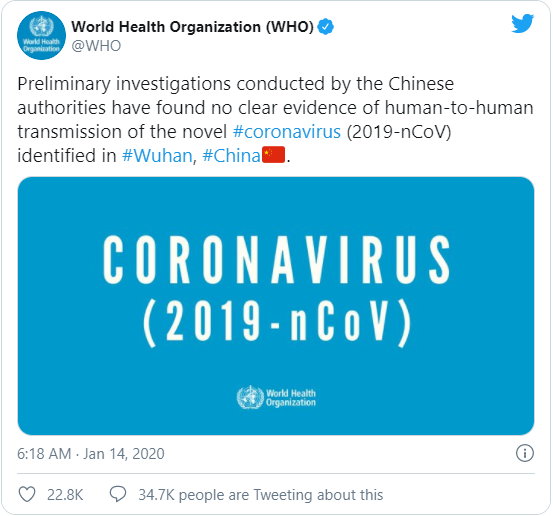
Jan. 15: Trump and China sign “phase one” of a trade deal to rein in a historic and damaging trade war.
Jan. 17: The CDC and the Department of Homeland Security announce that travelers into the U.S. from Wuhan will undergo new screening at several major airports.
Jan. 19: The WHO hedges somewhat: “Not enough is known to draw definitive conclusions about how it is transmitted, the clinical features of the disease, the extent to which it has spread, or its source, which remains unknown.”
Jan. 22: Trump responds to whether he’s concerned about a possible pandemic, “No. Not at all. And we have it totally under control. It’s one person coming in from China, and we have it under control. It’s going to be just fine.” Trump was referring to a resident from Snohomish County, Wash., who came back from China on Jan. 15 and was diagnosed with the coronavirus.

Jan. 23: Vox publishes an article stating that travel bans to fight viruses “don’t work.” The article initially referred to the “Wuhan coronavirus,” before being edited weeks later. The article’s URL remains unchanged.
China seals off Wuhan, canceling plane, train and bus travel.

Residents wearing face masks purchase seafood at a wet market on Jan. 28 in Macau, China. (Getty Images)
Anthony Fauci, director of the National Institute of Allergy and Infectious Diseases, says in a Journal of the American Medical Association podcast that the U.S. wouldn’t implement draconian shutdowns of cities like what was occurring in China: “There’s no chance in the world that we could do that to Chicago or to New York or to San Francisco, but they’re doing it. So, let’s see what happens.”
Jan. 24: Trump tweets in praise of China’s “transparency.” (On April 1, the Biden campaign mocked the president for the tweet, and claimed Biden “publicly” warned Trump not to trust China.)
Politico reports that the Trump administration held a briefing on the coronavirus for senators, but it was “sparsely attended” in part because it “was held on the same day as a deadline for senators to submit their impeachment questions.”
“The initial thought from the Dems, I think, is that we were trying to distract from impeachment,” a GOP Senate aide told Politico. The outlet added that a White House official “recalled feeling surprised at the ‘incredibly’ poor attendance, noting that it came ‘even though the amount of concern expressed then was rather intense.
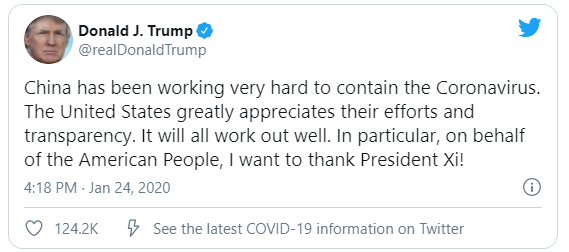
Jan. 26: “The American people should not be worried or frightened by this. It’s a very, very low risk to the United States,” Fauci says on The CATS Roundtable. “It isn’t something that the American public needs to worry about or be frightened about.”

Jan. 27: The Biden campaign, including its top coronavirus adviser Ron Klain, praise China for being “transparent” and “candid.” Speaking to Axios, Klain asserts: “I think what you’d have to say about China is, it’s been more transparent and more candid than it has been during past outbreaks, though still there’s problems with transparency and candor.” Even as he says there were “many” areas in which China hasn’t been transparent, Klain asserts that China had helpfully released a “sequence of the virus.” Klain goes on to say there isn’t “any reason” for anyone to postpone essential travel to anywhere except the Wuhan area. In fact, China reportedly destroyed virus samples rather than release them.
Jan. 28: Three days before Trump closes off most travel from China, Klain says he opposes that measure.
Jan. 30: CNN publishes a piece by Brandon Tensley entitled, “Coronavirus task force another example of Trump administration’s lack of diversity.” Tensley, who claims to cover the “intersection of culture and politics,” was unable to offer medical analysis in the article.
The WHO declares a global health emergency, and the State Department issues advisories against traveling to China.
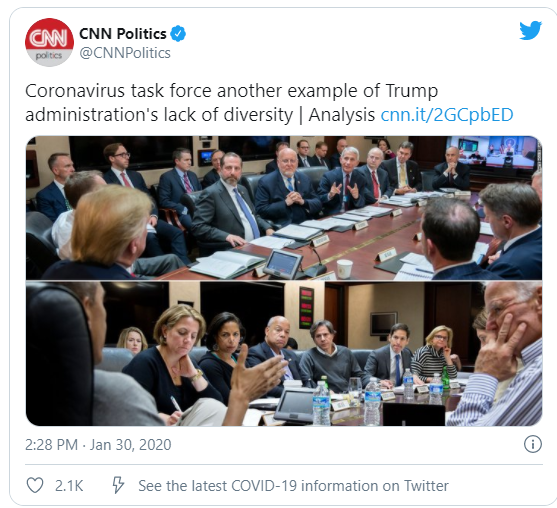
Also in the wake of the ban on Jan. 31:
- An article in The New York Times quotes epidemiologist Dr. Michael Osterholm as saying that Trump’s decision to restrict travel from China was “more of an emotional or political reaction.”
- The Washington Post runs a story quoting a Chinese official asking for “empathy” and slamming the White House for acting “in disregard of WHO recommendation against travel restrictions.”
- Vox tweets: “Is this going to be a deadly pandemic? No.” The tweet was deleted weeks later.
- Canada’s health minister Patty Hajdu, who would later say there was no reason to doubt Chinese coronavirus data, says the risk of the virus is “low” and that early-warning systems are working “exactly as they should.” The “spread of the disease is contained,” Hajdu claimed.
- Death counts indicated that 213 people had died and nearly 10,000 had been infected.
February
Feb. 2: “There’s a virus that has infected 15 million Americans across the country and killed more than 8,200 people this season alone,” CNN tweets. “It’s not a new pandemic — it’s influenza.”

Meanwhile, New York City Health Commissioner Oxiris Barbot tweets: “As we gear up to celebrate the #LunarNewYear in NYC, I want to assure New Yorkers that there is no reason for anyone to change their holiday plans, avoid the subway, or certain parts of the city because of #coronavirus.”
Feb. 4: In his State of the Union address, Trump remarks: “We are coordinating with the Chinese government and working closely together on the coronavirus outbreak in China. My administration will take all necessary steps to safeguard our citizens from this threat.” House Speaker Nancy Pelosi, D-Calif., rips up the speech as soon as it ends.
Feb. 5: Over 5,000 passengers on two cruise ships in Asia are ordered into quarantine as the worldwide death toll from the coronavirus reaches 490.
The Senate acquits Trump on two counts of impeachment, in a widely expected result that dominated journalists’ and politicians’ attention for months.
Feb. 7: Barbot strikes again, assuring residents, “We’re telling New Yorkers, go about your lives, take the subway, go out, enjoy life.” City lawmakers have called for Barbot to be fired because of the comments.
Feb. 9: Mark Levine, the chair of New York City Council health committee and a Democrat, tweets: “In powerful show of defiance of #coronavirus scare, huge crowds gathering in NYC’s Chinatown for ceremony ahead of annual #LunarNewYear parade. Chants of ‘be strong Wuhan!’ If you are staying away, you are missing out!
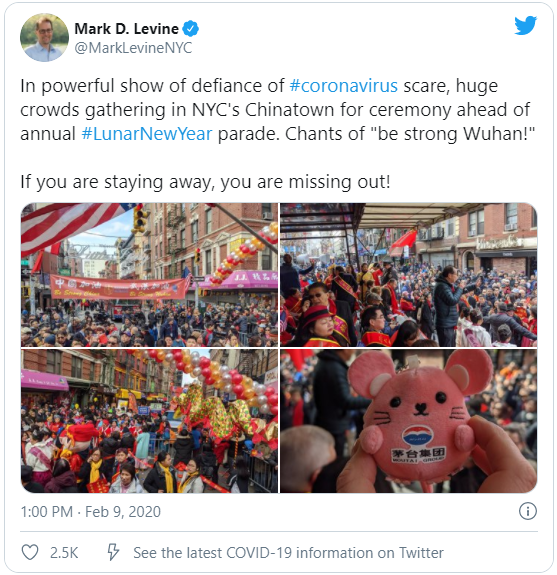
Feb. 11: Klain, the Biden adviser, remarks that the evidence “suggests” the coronavirus won’t be a “serious pandemic.
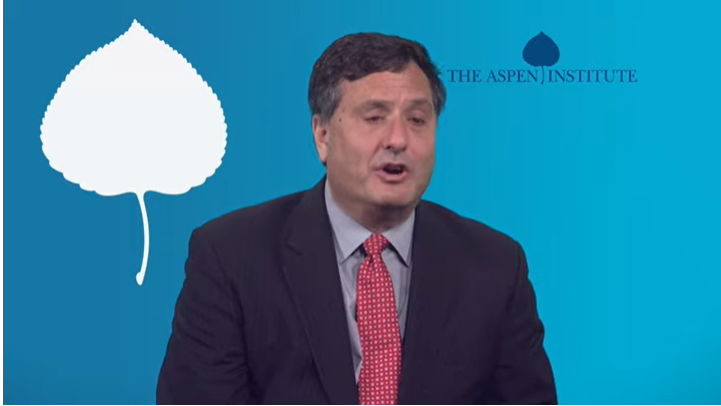
Feb. 13: “There are ZERO confirmed cases of coronavirus in New York City, and hundreds of Chinese restaurants that need your business!” the New York City mayor’s office tweets. “There is nothing to fear. Stop by any Chinatown for lunch or dinner!”
New York City Mayor Bill de Blasio adds: “It was my honor to spend time with our Asian-American owned small businesses in Flushing today. This vibrant community is standing strong but they need YOUR support. Our Chinatowns are open for business — make some dinner plans, do some shopping and stand with our neighbors!”
Klain then praises de Blasio: “We don’t have a #COVIDー19 epidemic in the US but we are starting to see a fear epidemic. Kudos to @NYCMayor (and others) for standing against that.”
Feb 14: France announces Europe’s first coronavirus death.
Feb. 17: Fauci announces that the risk of coronavirus infection in the U.S. is “miniscule,” according to USA Today. Fauci, one of the top experts in the field and a senior White House coronavirus adviser, also told the paper that people shouldn’t wear masks unless they are contagious. (By April 3, Fauci appeared to endorse national stay-at-home orders.)
Feb. 18: In remarks at Joint Base Andrews, Trump states: “I think President Xi is working very hard. As you know, I spoke with him recently. He’s working really hard. It’s a tough problem. I think he’s going to do — look, I’ve seen them build hospitals in a short period of time. I really believe he wants to get that done, and he wants to get it done fast. Yes, I think he’s doing it very professionally. We’re also working with him and helping him, as of the last few days, as you know.” Pressed on whether he trusted China’s coronavirus data, Trump responds, “Look, I know this: President Xi loves the people of China, he loves his country, and he’s doing a very good job with a very, very tough situation.”
Feb. 19: Iran reports two coronavirus cases — the country’s first. Hundreds of passengers leave the Diamond Princess for the first time since the quarantine.
Feb. 23: Coronavirus infections surge in Italy and South Korea; authorities in Italy begin locking down towns.
Feb. 24: “It’s exciting to be here, especially at this time, to be able to be unified with our community,” House Speaker Nancy Pelosi, D-Calif., tells reporters as she visits San Francisco’s Chinatown. “We want to be vigilant about what is out there in other places. We want to be careful about how we deal with it, but we do want to say to people ‘Come to Chinatown, here we are — we’re, again, careful, safe — and come join us.’”
Also on Feb. 24, the White House submits a request to Congress for $2.5 billion in supplemental spending to help combat the coronavirus outbreak. The request includes $1.25 billion in new money, with the rest coming from unspent funds. The budget request languishes in Congress, and the House of Representatives takes no action to bring it up for a vote.

Feb. 28: At a campaign rally, Trump calls Democrats’ criticisms of his coronavirus response “their new hoax.” Biden and other Democrats then falsely accused Trump of calling the virus itself a hoax. Several fact-checkers, including The Washington Post, make clear that Trump was referring to the Democrats’ response to the virus.
Feb. 29: The first coronavirus death in the U.S. is confirmed in Washington state.
March
Mar. 2: “Since I’m encouraging New Yorkers to go on with your lives + get out on the town despite Coronavirus, I thought I would offer some suggestions,” de Blasio, the mayor of New York City, tweets. “Here’s the first: thru Thurs 3/5 go see ‘The Traitor’ @FilmLinc. If ‘The Wire’ was a true story + set in Italy, it would be this film.
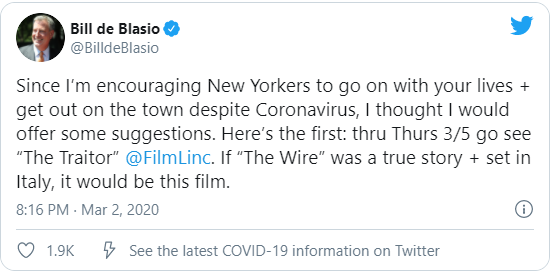
Mar. 4: Barbot, the top New York City health official, declares, “There’s no indication that being in a car, being in the subways with someone who’s potentially sick is a risk factor.”
On CNN, Anderson Cooper and Dr. Sanjay Gupta downplay the virus.
“The flu right now is far deadlier,” Cooper says. “So if you’re freaked out at all about the coronavirus you should be more concerned about the flu, and you can actually do something about it, and get a flu shot.”
“15,000 people roughly have already died of the flu this season,” Gupta responded. “Couple years ago, 60,000 people died of the flu.
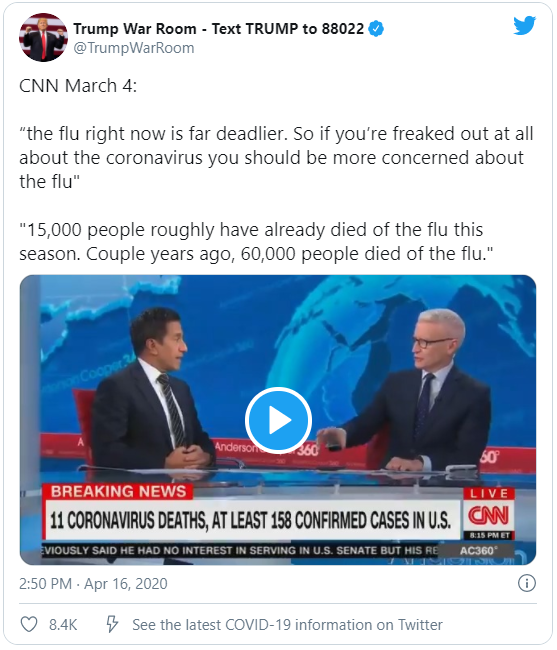
Mar. 9: At a Fox News town hall, Bernie Sanders says he would not close the border, even if it were necessary to halt the spread of coronavirus. He then attacked Trump’s “xenophobia.”
Also on this day, Fauci remarks that going to campaign rallies may not be a bad idea: “You know, I can’t comment on campaign rallies. It really depends. We are having as we all said — this is something in motion. This is an evolving thing. So I’m not sure what we’re going to be able to say at the time we’re going to have a campaign rally. If you’re talking about a campaign rally tomorrow, in a place where there is no community spread, I think the judgment to have it might be a good judgment. [But] if you want to talk about large gatherings in a place you have community spread, I think that’s a judgment call, and if someone decides they want to cancel it, I wouldn’t publicly criticize them.”
Mar. 11: Trump blocks most travel from continental Europe.
Meanwhile, Trump declares a national emergency, authorizing $50 billion in federal funds to go to the states.
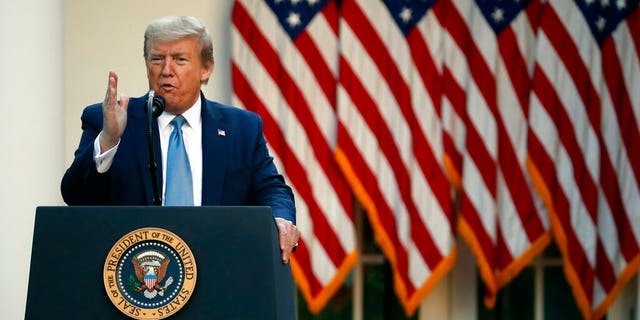
President Donald Trump speaks about the coronavirus in the Rose Garden of the White House, Wednesday, April 15, 2020, in Washington. (AP Photo/Alex Brandon)
Mar. 17: France imposes a nationwide lockdown. European Union leaders agree to mostly seal off the bloc for 30 days.
Mar. 23: Britain imposes a nationwide lockdown.
Mar. 24: India imposes a nationwide lockdown.
Mar. 27: A senior WHO official cuts off an interview after a reporter implies Taiwan, which is not a WHO member state, is independent of China. The official, Canadian doctor Bruce Aylward, initially pretended not to hear the question before terminating the Skype call with the reporter.
Trump signs a $2 trillion stimulus bill into law.
Mar. 30: Virginia, Maryland and Washington, D.C. issue stay-at-home orders, joining other states. In all, approximately 265 million Americans are now under indefinite lockdown.

